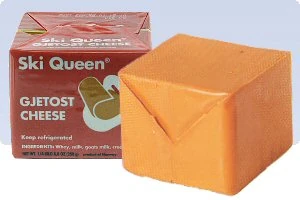
|
This page uses content from Wikipedia. The original article was at Gjetost. The list of authors can be seen in the page history. As with WikiCheese, the text of Wikipedia is available under the Creative Commons Attribution-Share Alike License 3.0 (Unported) (CC-BY-SA). |
The word gjetost, also spelled geitost, consists of "geit" and "ost", Norwegian for "goat" and "cheese". The name brunost means 'brown cheese', while the specific type gudbrandsdalsost means 'cheese from the Gudbrand valley'.
It has a strong, sweet, yet somewhat sharp flavor with notes of caramel and goat's milk. It tastes best when freshly sliced very thin and it pairs very well with coffee. It is a very popular topping for the customary open sandwiches eaten at breakfast and supper in Norway.
Gjetost can be used with much success in cooking, such as various game sauces, often along with juniper, which provides a subtle caramel taste.
Production[]
Cow or goat milk and cream are added to whey. The mixture is boiled carefully for several hours so that the water evaporates. The heat turns the milk sugar into caramel, which gives the cheese its characteristic taste. It is ready for consumption as soon as it is packed in suitable sized blocks.
If boiled for a shorter time than usual, one gets the spreadable version prim, or messmör in Swedish. Prim had been made in Norway for a long time when Anne Hov, a farmer's wife got the idea of putting cream into the cheese. She got a good price for her new fatty cheese, and this merchandise is said to have saved the Gudbransdal valley financially in the 1880s.
Today, several types of geitost are offered in most shops in Norway. TINE meierier produce most of the geitost. Several local dairies produce their own versions. Experimental versions with nuts and honey or chocolate have been tried, without very much success.
